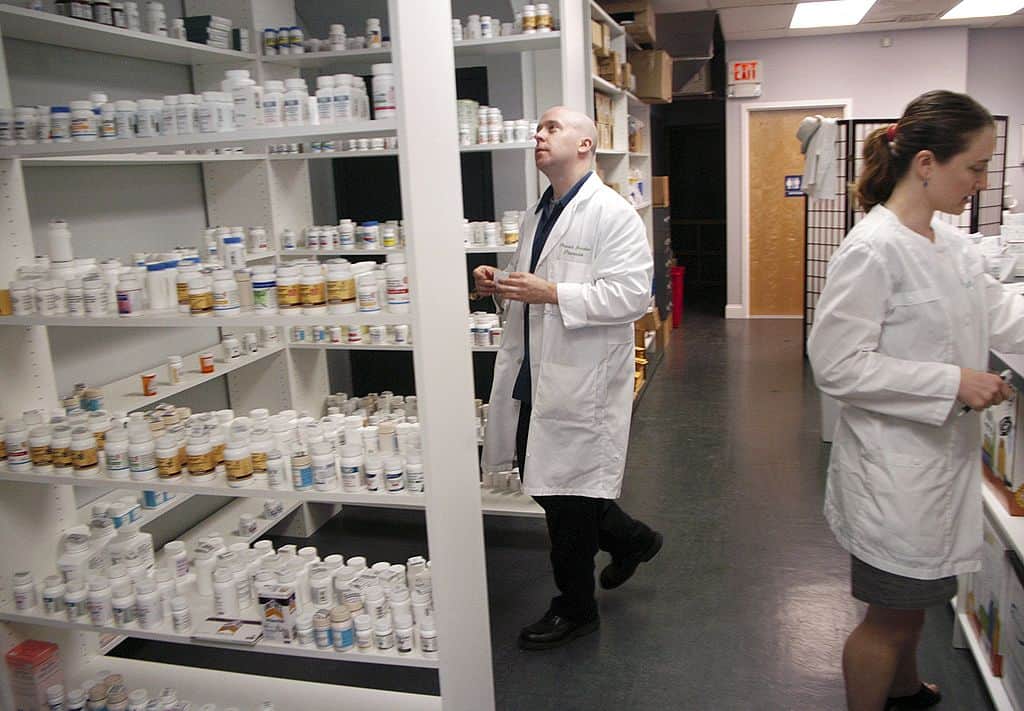Drug Makers Invest in Radiopharmaceuticals

Pharmaceuticals manufacturers are increasingly turning to radioactive drugs in their battle against cancers (CNBC).
What’s going on: Eli Lily, Bristol Myers Squibb and others “have spent some $10 billion on deals to acquire or work with radiopharmaceuticals makers,” which produce drugs containing radioactive isotopes, predicting that the technology will be effective in treating multiple cancer types.
- Meanwhile, Novartis already has two radiopharmaceuticals, Pluvicto and Lutathera, available for cancer treatment, and several dozen more in development.
How it works: Radiopharmaceutical “drugs work by attaching radioactive material to a targeting molecule that searches for and attaches to a specific marker on cancer cells. The trick is finding markers that exist on cancer cells but not healthy cells. That can allow the treatment to deliver radiation to cancer cells and spare the rest of the body from the level of damage that comes with many cancer drugs.”
- Bristol Myers Squibb sees “opportunity [in] … combining radiopharmaceuticals with existing cancer drugs like immunotherapy, said Robert Plenge, Bristol’s chief research officer.”
More interest: Though radiopharmaceuticals have been around since the 1940s, they’ve only begun drawing big interest in recent years.
- Early this year, Bristol Myers Squibb completed a $4.1 billion acquisition of radiopharmaceutical startup RayzeBio.
- In 2023, Eli Lilly acquired radiopharmaceutical company Point Biopharma and signed partnerships with businesses that are developing treatments.
In-house production: Among the key criteria in Lilly’s search for a firm to acquire: “whether companies were prepared to manufacture the drugs,” according to Eli Lilly Executive Vice President and President of Lilly Oncology Jacob Van Naarden.
- “Radiopharmaceuticals aren’t easy to make, and Lilly wanted to make sure any initial acquisition could produce the drugs themselves instead of outsourcing the work.”
Safety and speed are everything: Each dose of Novartis’ Pluvicto has a GPS tracker to make sure it goes to the correct patient at the correct time, said Victor Bulto, president of the U.S. unit for Novartis. That’s because the therapies are only good for a few days once made.
- Novartis is “investing more than $300 million to open and expand radiopharmaceutical manufacturing sites in the U.S. so it can produce the drug and get it to patients quickly.”
- The pharmaceutical company “drives doses to destinations that are within nine hours from the factory to minimize the risk of disruptions from storms, Bulto said.”
Special considerations: Radiopharmaceuticals come with unique challenges.
- One health care network had to upgrade its medical license before it could be allowed to handle radioactive materials, and “[a] certified specialist needs to administer the drugs, which are given intravenously.”
- To avoid exposing people to radiation, patients taking the treatments must remain at a distance from others for a week or more following the injections, which they get every six weeks.
Big opportunity: Though full understanding of radiopharmaceuticals’ potential may be years away, “[i]f we can be successful in expanding the target and tumor type repertoire, this could be a very big class of medicines,” Van Naarden said.
Rep. Buddy Carter Calls for PBM Reform, Tax Action at RYAM

Rep. Earl L. “Buddy” Carter (R-GA), a staunch advocate for health care reform and a community pharmacist by profession, visited RYAM’s manufacturing facility in Jesup, Georgia, in August to discuss manufacturers’ health care and tax policy priorities.
During the visit, Rep. Carter emphasized the critical need for pharmacy benefit manager reform as well as tax policies that support manufacturers’ growth and competitiveness.
The visit: Clay Bethea, RYAM’s Jesup plant general manager and vice president of U.S. wood procurement, led Rep. Carter on a tour of the cellulose specialties manufacturer’s facility, where he observed how pulp is dried and finished into sheets and rolls. Bethea highlighted the significant challenges the company faces due to rising costs in health care, particularly those driven by PBMs, and the looming expiration of key tax provisions in 2025.
- “We are proud to be a part of this community, creating jobs and driving economic growth,” Bethea said. “However, the rising costs of health care, particularly due to PBMs, and the uncertainty around critical tax provisions like R&D expensing and accelerated depreciation, are growing concerns for both our business and our employees. Reforming PBMs and maintaining tax policies that allow us to invest for the future are crucial to our ability to remain competitive globally.”
PBM reform: Rep. Carter has long been vocal about the need to hold PBMs accountable for their role in inflating health care costs.
- “PBMs have become powerful middlemen, often driving up drug prices while squeezing independent pharmacies out of the market,” Rep. Carter said during the tour. “It’s time for Congress to bring transparency and fairness back to the system.”
- Carter has introduced and supported several pieces of legislation designed to reform PBM practices, including a bill aimed at delinking PBM compensation from drug prices, improving PBM payments to pharmacies and increasing transparency.
Tax challenges: In addition to health care, Rep. Carter addressed the pressing issue of preserving tax reform.
- “The expiration of accelerated depreciation, R&D expensing and favorable tax rates could significantly hamper the manufacturing industry’s ability to grow and remain competitive globally,” Rep. Carter warned.
- “These tax provisions have been crucial for manufacturers like RYAM, enabling them to make significant investments in their operations and workforce. Losing them would not only impact these companies’ ability to innovate but also jeopardize jobs and economic growth in communities across the country.”
NAM in action: The NAM has long advocated for both PBM reform and the preservation of essential tax policies that drive the manufacturing industry.
- “PBMs are a significant driver of the rising costs of health care, and reform is essential to ensure that manufacturers can provide affordable benefits to their workers,” said NAM Vice President of Domestic Policy Charles Crain.
- “Congress also needs to act with urgency to prevent devastating tax increases scheduled for next year that will impact manufacturers across the country.”
The state-level view: Lloyd Avram, president and CEO of the Georgia Association of Manufacturers, echoed Rep. Carter’s concerns.
- “Manufacturers across Georgia are facing unsustainable health care expenses, and the uncertainty surrounding federal tax provisions only adds to the challenges,” Avram said. “Action on PBM reform and tax policy is essential to helping our industry remain competitive and continue providing good jobs in our communities.”
The bottom line: “Reducing health care costs and increasing transparency in the PBM system are crucial steps in lowering the overall cost of doing business in the U.S.,” said Rep. Carter. “However, to truly compete in the global economy, it’s important that we preserve the policies that have empowered manufacturers to innovate, expand and sustain jobs. Otherwise, the U.S. risks becoming a less attractive place for manufacturing investment, ultimately threatening our economic leadership on the world stage.”
Manufacturers: Price Controls Harm Innovation, Therapies and Cures; Congress Should Look at PBMs to Cut Drug Costs
Washington, D.C. – Following the release of prices set for the first 10 prescription drugs that were subject to price controls under the Inflation Reduction Act, National Association of Manufacturers President and CEO Jay Timmons released the following statement:
“The pricing mandates released by the Department of Health and Human Services on groundbreaking medicines harm innovation and will slow the development of needed therapies and cures by hampering manufacturers’ ability to pioneer new drugs and treatments. America has led the way in medical and scientific breakthroughs to battle the most devastating and severe illnesses and conditions. There are so many more diseases for which we need to find a cure—like cancer, juvenile diabetes and Alzheimer’s to name just three—and this price control scheme threatens our ability to do so.
“Health care manufacturers in the U.S. invest more than $100 billion annually to create new medicines, putting nearly 17% of their sales right back into R&D. Developing and putting a new drug on the market is a particularly costly and risky endeavor, costing $2.3 billion and taking 15 years, on average. More than 90% of experimental drugs ultimately fail, resulting in billions of dollars of lost investment. But biopharmaceutical manufacturers are committed to finding treatments and cures to devastating diseases like cancer.
“Price controls will limit R&D, plain and simple, as every dollar of revenue curtailed by price controls is a dollar that can’t be devoted toward the astronomically high cost of developing a new medicine.
“This will have an immediate impact on the White House’s manufacturing strategy. Manufacturers are ready to take the lead following President Biden’s announcement Tuesday of $150 million in grants toward his Cancer Moonshot initiative, to prevent more than 4 million cancer-related deaths by 2047, but we’re concerned that goal could be hampered and delayed by the mandates within the IRA.
“There is ultimately a human cost to anything that slows or halts biopharmaceutical manufacturers’ work to develop new treatments or expand production and make those treatments more widely available. Americans’ quality of life will suffer—or they may even lose their lives—because a new treatment was not available in time.
“To truly help Americans, Congress should begin by curtailing the middlemen who are really driving up the prices without giving anything back, such as pharmacy benefit managers. PBMs have severely distorted the cost of pharmaceuticals and lifesaving therapies, driving up the price for patients and employers alike. PBM reform is the way to drive down costs.”
-NAM-
The National Association of Manufacturers is the largest manufacturing association in the United States, representing small and large manufacturers in every industrial sector and in all 50 states. Manufacturing employs nearly 13 million men and women, contributes $2.89 trillion to the U.S. economy annually and accounts for 53% of private-sector research and development. The NAM is the powerful voice of the manufacturing community and the leading advocate for a policy agenda that helps manufacturers compete in the global economy and create jobs across the United States. For more information about the NAM or to follow us on Twitter and Facebook, please visit www.nam.org.
NAM Leads Effort to Reform PBMs

Middlemen created to manage the price of prescription drugs are instead driving up health care costs for manufacturers and manufacturing workers, the NAM told the House Committee on Oversight and Accountability on Tuesday, the same day the committee released a report on pharmacy benefit managers’ practices and held a hearing on the matter.
What’s going on: “PBMs’ business models have the direct effect of increasing health care costs at the expense of manufacturers and manufacturing workers,” NAM Vice President of Domestic Policy Charles Crain said in advance of the hearing, the latest in a series examining PBM practices.
Crain told lawmakers PBM reform legislation should include:
- “Increased transparency into PBMs’ business models and the many factors that contribute to a drug’s costs, formulary placement and the PBMs’ compensation;
- Rebate passthrough, which will ensure 100% of negotiated pharmaceutical savings are passed from the PBM to the health plan sponsor and workers; and
- Delinking of PBM compensation from the list price of medication.”
Report highlights: The committee’s report, the culmination of a 16-month investigation, is in line with the NAM’s longstanding advocacy. The report found that PBMs:
- Drive increased drug prices, which inflate PBM profits;
- Extract high rebates from biopharmaceutical manufacturers, often pocketing a significant portion of any savings rather than reducing costs for patients;
- Dictate whether and how medicines appear on formularies, which determine insurance companies’ coverage decisions and patients’ out-of-pocket costs;
- Steer patients toward drugs based on PBMs’ profit margins rather than patient costs; and
- Operate without sufficient transparency into their business practices.
What it all means: The committee “identified numerous instances where the federal government, states and private payers have found PBMs to have utilized opaque pricing and utilization schemes to overcharge plans and payers by hundreds of millions of dollars,” the report states.
- The report indicates that the present role of PBMs in prescription drug markets is failing and requires change, something the NAM has long advocated. “Congress and states must implement legislative reforms to increase the transparency of the PBM market and ensure patients are placed at the center of our health care system, rather than PBMs’ profits.”
The last word: “Manufacturers provide health care benefits so they can effectively attract and retain employees, to maintain a healthy and productive workforce and because they believe it is the right thing to do—but PBMs are a meaningful cause of the skyrocketing costs of health care,” Crain said.
- “Congress must enact reforms to the PBM system so that employers can negotiate, compete and achieve health care savings for their workers.”
NYT Investigation: Pharmacy Benefit Managers Drive Up Costs for Employers

Although they were created to keep prescription drug prices down, pharmacy benefit managers “frequently do the opposite” (The New York Times, subscription)—and that’s one of the main reasons the NAM has long advocated for their reform.
What’s going on: “The job of the P.B.M.s is to reduce drug costs. Instead, they …
steer patients toward pricier drugs, charge steep markups on what would otherwise be inexpensive medicines and extract billions of dollars in hidden fees, a New York Times investigation found.”
Why it’s important: PBMs frequently charge employers and government programs, such as Medicare, many times the wholesale cost of a medication and keep the difference, according to the Times.
- And it’s not just those taking prescriptions who pay; when drug costs are inflated, everyone ends up paying higher insurance premiums.
- What’s more, “[b]ecause of recent mergers, [the big three PBMs] are becoming more dominant, collectively processing roughly 80 percent of prescriptions in the United States.” That’s up more than 30% from just 12 years ago.
Working around a workaround: In 2018, in response to growing pressure from employers to get PBMs to share more of the discounts from drug manufacturers, PBMs set up entities known as group purchasing organizations.
- These GPOs pass savings to employers—but they “also began imposing new fees on drug manufacturers,” money they were not contractually bound to pass on to clients.
- The result: “Employers are none the wiser. They receive rebates. But they can’t see the billions of dollars in fees that the G.P.O.s take for themselves.”
Congress makes moves: Since the beginning of last year, seven House and Senate committees have passed PBM-reform legislation, including policies to increase transparency into PBMs’ business practices, delink PBM compensation from medications’ list prices and ensure that rebates are fully passed through to the plan sponsor or patient.
- The NAM has been crucial in educating lawmakers on the need for these reforms and continues to advocate for PBM reform to be signed into law this year.
The last word: “PBMs drive up health care costs for manufacturers and manufacturing workers,” said NAM Vice President of Domestic Policy Charles Crain. “Congress must act as soon as possible to enact comprehensive PBM reform that benefits employers by making PBM contracts more straightforward, transparent and predictable—and benefits workers by reducing the prices they pay out of pocket for their prescriptions.”
House Committee Approves PBM Reforms

The House Ways and Means Committee unanimously passed legislation Wednesday that includes much-needed reforms to pharmacy benefit managers, underregulated middlemen that raise health care costs for manufacturers and manufacturing workers (Fierce Healthcare).
What’s going on: PBM reforms contained in the Preserving Telehealth, Hospital and Ambulance Access Act include increasing transparency into PBMs’ business practices and delinking PBM compensation from medicines’ list prices. These changes will help reduce prices for seniors who rely on Medicare prescription drug plans.
- The NAM has been instrumental in advancing these reforms.
Why it’s important: “When Americans face soaring prices for medicines or treatments, there’s a good chance that is because a PBM has driven up the price,” NAM President and CEO Jay Timmons said Wednesday.
- “These middlemen operate with minimal transparency, and their practices distort the market, increasing the list prices patients pay for medicines while making it more difficult for manufacturers to offer quality, affordable health care benefits.”
What’s next: The legislation approved Wednesday applies to the Medicare market. The NAM is calling on Congress to enact similar changes in the commercial insurance market to lower health care costs for manufacturing employees who participate in employer-sponsored plans.
Manufacturers Commend House Ways and Means Committee’s Efforts Toward Comprehensive PBM Reform
Bill Would Protect Seniors and Set the Stage for Broader Reforms
Washington, D.C. – Following the House Ways and Means Committee’s unanimous approval of legislation to reform pharmacy benefit managers—middlemen who unfairly increase the prices that patients pay at the pharmacy counter by controlling negotiations between insurers and biopharmaceutical manufacturers—in Medicare markets, National Association of Manufacturers President and CEO Jay Timmons released the following statement:
“The NAM commends the Ways and Means Committee for unanimously taking a powerful step toward reforming the PBM system and lowering the cost of health care for all Americans.
“When Americans face soaring prices for medicines or treatments, there’s a good chance that is because a PBM has driven up the price. These middlemen operate with minimal transparency, and their practices distort the market, increasing the list prices patients pay for medicines while making it more difficult for manufacturers to offer quality, affordable health care benefits.
“By increasing transparency into PBMs’ business models and delinking their compensation from a medicine’s list price, these critical PBM provisions will significantly reduce costs for seniors who rely on Medicare for health care coverage. Congress should advance these important reforms.
“In addition, manufacturers encourage Congress to enact similar reforms in the commercial insurance market to bring down health care costs for manufacturing workers participating in employer-sponsored plans.”
-NAM-
The National Association of Manufacturers is the largest manufacturing association in the United States, representing small and large manufacturers in every industrial sector and in all 50 states. Manufacturing employs nearly 13 million men and women, contributes $2.89 trillion to the U.S. economy annually and accounts for 53% of private-sector research and development. The NAM is the powerful voice of the manufacturing community and the leading advocate for a policy agenda that helps manufacturers compete in the global economy and create jobs across the United States. For more information about the NAM or to follow us on Twitter and Facebook, please visit www.nam.org.
NAM Stands Up for Biopharmaceutical Innovation Before Senate Hearing

In advance of a Senate hearing on health care costs, the NAM is ensuring that senators understand the importance of biopharmaceutical innovation to patients and the U.S. economy—and the damaging impact of policies that hinder drug development.
What’s happening: The Senate Armed Services Committee will hold a subcommittee hearing today on whether harmful policies like price controls, compulsory licensing and weaker intellectual property protections for new medicines could reduce servicemembers’ health care costs.
NAM pushes back: The NAM is highlighting the extraordinary investment—in both time and capital—that it takes to bring a lifesaving treatment to market. According to the NAM:
- The average cost of developing a new drug was $2.3 billion as of 2022;
- Across the industry, biopharmaceutical manufacturers spent $139 billion on R&D in just 2022 alone;
- It can take 10 to 15 years for a breakthrough scientific discovery to move through early-stage research, clinical trials, Food and Drug Administration approval and manufacturing; and
- Only 12% of investigational drugs that enter a Phase I clinical trial ultimately receive FDA approval—to say nothing of the hundreds of discoveries that never make it into clinical trials.
Lifesaving impact: In 2023, the FDA approved a record-breaking 71 new medicines that will improve the lives of patients.
- The biopharmaceutical industry behind these breakthroughs is also stimulating the U.S. economy: Biopharmaceutical manufacturers accounted for $355 billion in value-added output to the U.S. economy in 2021 and directly employed 291,000 workers in the U.S.
Innovation under threat: In recent years, biopharmaceutical manufacturers have been subject to harmful policies that will limit innovation and slow efforts to develop lifesaving medicines.
- The Medicare Drug Price Negotiation Program subjects life-changing biopharmaceutical innovations to government price controls, while the Biden administration’s “march-in” proposal undermines innovators’ IP rights. These policies make it riskier and more costly for manufacturers to invest in groundbreaking research.
- What’s more, the prices Americans pay for medicines are influenced heavily by middlemen, such as pharmacy benefit managers rather than biopharma companies. In 2020, more than half of every dollar spent on brand medicines went to PBMs and others in the health care system—not the medicine’s manufacturer.
The final word: “The costs of manufacturing a medicine include potentially decades of research and billions of dollars of investment,” said NAM Vice President of Domestic Policy Charles Crain. “Congress must avoid adopting policies that will stymie this lifesaving innovation.”
NAM Stands Up for Biopharmaceutical Innovation Before Senate Hearing

In advance of a Senate hearing on health care costs, the NAM is ensuring that senators understand the importance of biopharmaceutical innovation to patients and the U.S. economy—and the damaging impact of policies that hinder drug development.
What’s happening: The Senate Armed Services Committee will hold a subcommittee hearing today on whether harmful policies like price controls, compulsory licensing and weaker intellectual property protections for new medicines could reduce servicemembers’ health care costs.
NAM pushes back: The NAM is highlighting the extraordinary investment—in both time and capital—that it takes to bring a lifesaving treatment to market. According to the NAM:
- The average cost of developing a new drug was $2.3 billion as of 2022;
- Across the industry, biopharmaceutical manufacturers spent $139 billion on R&D in just 2022 alone;
- It can take 10 to 15 years for a breakthrough scientific discovery to move through early-stage research, clinical trials, Food and Drug Administration approval and manufacturing; and
- Only 12% of investigational drugs that enter a Phase I clinical trial ultimately receive FDA approval—to say nothing of the hundreds of discoveries that never make it into clinical trials.
Lifesaving impact: In 2023, the FDA approved a record-breaking 71 new medicines that will improve the lives of patients.
- The biopharmaceutical industry behind these breakthroughs is also stimulating the U.S. economy: Biopharmaceutical manufacturers accounted for $355 billion in value-added output to the U.S. economy in 2021 and directly employed 291,000 workers in the U.S.
Innovation under threat: In recent years, biopharmaceutical manufacturers have been subject to harmful policies that will limit innovation and slow efforts to develop lifesaving medicines.
Read the full story here.
NAM Helps Strike Forced IP Transfer from WHO Draft

In a significant change that protects manufacturers’ intellectual property rights, an updated draft of the World Health Organization’s pandemic agreement no longer includes IP language that would have pressured or compelled manufacturers to turn their innovations over to foreign countries, including competitors such as China, POLITICO Pro (subscription) reports.
- Convincing organizations such as the WHO to reject forced IP transfers has been a top priority for the NAM, and this week’s announcement represents significant progress for manufacturers.
What’s going on: “The latest text has scrapped a clause stating countries will ‘consider supporting’ time-bound suspensions of intellectual property rights during pandemics. Instead, each country will consider supporting ‘appropriate measures’ to scale up the manufacture of products that could help stymie a future pandemic.”
- The draft is set to be put to WHO members next month for a vote at the 77th World Health Assembly in Geneva, Switzerland.
- Subject to applicable laws, under the draft agreement countries will also be required to “support … capacity-building for the transfer of technology and knowhow for pandemic-related health products on mutually agreed terms.”
- The text indicates that the pathogen access and benefit sharing system—which would require nations to share pathogen information “with the WHO in exchange for access to the resulting health products developed to fight the new threat”—is still under negotiation. Thus far, countries have been unable to agree on the terms of that exchange.
Why it’s important: IP waivers would significantly harm manufacturers and their ability to compete globally.
- The NAM led the charge with regard to the World Trade Organization earlier this year, when it warned policymakers in the U.S. and abroad about the problems inherent in expanding the WTO’s 2022 TRIPS waiver on IP rights to include COVID-19 therapeutics and diagnostics.
- As a result of that advocacy, the waiver was ultimately kept out of the WTO’s final Ministerial Declaration last month.
- In addition, in January, the NAM responded to the U.S. Department of Health and Human Services’ request for comments regarding the WHO’s pandemic preparedness agreement. The NAM urged that any IP waiver be removed from the WHO text.
The funding issue: Another challenge the WHO text puts off is the financing of all the initiatives it lays out.
- While it mentions establishing a “coordinating financial mechanism,” it does not detail how the mechanism would work.
